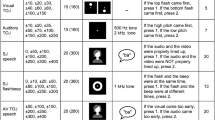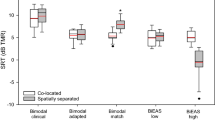Abstract
One of the key benefits of using cochlear implants (CIs) in both ears rather than just one is improved localization. It is likely that in complex listening scenes, improved localization allows bilateral CI users to orient toward talkers to improve signal-to-noise ratios and gain access to visual cues, but to date, that conjecture has not been tested. To obtain an objective measure of that benefit, seven bilateral CI users were assessed for both auditory-only and audio-visual speech intelligibility in noise using a novel dynamic spatial audio-visual test paradigm. For each trial conducted in spatially distributed noise, first, an auditory-only cueing phrase that was spoken by one of four talkers was selected and presented from one of four locations. Shortly afterward, a target sentence was presented that was either audio-visual or, in another test configuration, audio-only and was spoken by the same talker and from the same location as the cueing phrase. During the target presentation, visual distractors were added at other spatial locations. Results showed that in terms of speech reception thresholds (SRTs), the average improvement for bilateral listening over the better performing ear alone was 9 dB for the audio-visual mode, and 3 dB for audition-alone. Comparison of bilateral performance for audio-visual and audition-alone showed that inclusion of visual cues led to an average SRT improvement of 5 dB. For unilateral device use, no such benefit arose, presumably due to the greatly reduced ability to localize the target talker to acquire visual information. The bilateral CI speech intelligibility advantage over the better ear in the present study is much larger than that previously reported for static talker locations and indicates greater everyday speech benefits and improved cost-benefit than estimated to date.




Similar content being viewed by others
References
Bench J, Kowal A, Bamford J (1979) The BKB (Bamford-Kowal-Bench) sentence lists for partially-hearing children. Br J Audiol 13(3):108–12
Buss E, Pillsbury HC, Buchman CA, Pillsbury CH, Clark MS, Haynes DS, Labadie RF, Amberg S, Roland PS, Kruger P, Novak MA, Wirth JA, Black JM, Peters R, Lake J, Wackym PA, Firszt JB, Wilson BS, Lawson DT, Schatzer R, D’Haese PS, Barco AL (2008) Multicenter US bilateral MED-EL cochlear implantation study: speech perception over the first year of use. Ear Hear 29:20–32
Culling JF, Hawley ML, Litovsky RY (2004) The role of head-induced interaural time and level differences in the speech reception threshold for multiple interfering sound sources. J Acoust Soc Amer 116:1057–1065
Culling JF, Jelfs S, Talbert A, Grange JA, Backhouse SS (2012) The benefit of bilateral versus unilateral cochlear implantation to speech intelligibility in noise. Ear Hear 33(6):673–82
Desai S, Stickney G, Zeng FG (2008) Auditory-visual speech perception in normal-hearing and cochlear-implant listeners. J Acoust Soc Am 123(1):428–440
Erber NP (1972) Auditory, visual, and AV recognition of consonants by children with normal and impaired hearing. Journal of Speech and Hearing Research 15:413–422
Gantz BJ, Tyler RS, Rubinstein JT, Wolaver A, Lowder M, Abbas P, Brown C, Hughes M, Preece J (2002) Binaural cochlear implants placed during the same operation. Otol Neurotol 23:169–180
Grantham W, Ashmead DH, Ricketts TA, Labadie RF, Haynes DS (2007) Horizontal-plane localization in noise and speech signals by postlingually deafened adults fitted with bilateral cochlear implants. Ear Hear 28:524–541
Hawley ML, Litovsky RY, Culling JF (2004) The benefit of binaural hearing in a cocktail party: effect of location and type of interferer. J Acoust Soc Amer 115:833–843
Kerber S, Seeber BU (2012) Sound localization in noise by normal-hearing listeners and cochlear implant users. Ear Hear 33(4):445–57
Kerber S, Seeber BU (2013) Sound localization in noise by normal-hearing listeners and cochlear implant users. Ear Hear 33(4):445–57
Koch DB, Soli SD, Downing M, Osberger MJ (2009) Simultaneous bilateral cochlear implantation: prospective study in adults. Cochlear Implants International 11(2):84–99
Laske RD, Veraguth D, Dillier N, Binkert A, Holzmann D, Huber AM (2009) Subjective and objective results after bilateral cochlear implantation in adults. Otol Neurotol 30:313–318
Laszig R, Aschendorff A, Stecker M, Müller-Deile J, Maune S, Dillier N, Weber B, Hey M, Begall K, Lenarz T, Battmer RD, Böhm M, Steffens T, Strutz J, Linder T, Probst R, Allum J, Westhofen M, Doering W (2004) Benefits of bilateral electrical stimulation with the nucleus cochlear implant in adults: 6-month postoperative results. Otol Neurotol 25:958–968
Litovsky R, Parkinson A, Arcaroli J, Sammeth C (2006) Simultaneous bilateral cochlear implantation in adults: a multicenter clinical study. Ear Hear 27:714–731
Litovsky RY, Parkinson A, Arcaroli J (2009) Spatial hearing and speech intelligibility in bilateral cochlear implant users. Ear Hear 30:419–431
Loizou P, Hu Y, Litovsky RY, Yu G, Peters R, Lake J, Roland P (2009) Speech recognition by bilateral cochlear implant users in a cocktail party setting. J Acoust Soc Am 125:372–383
Müller J, Schön F, Helms J (2002) Speech understanding in quiet and noise in bilateral users of the MED-EL COMBI 40/40+ cochlear implant system. Ear Hear 23:198–206
Neuman AC, Haravon A, Sislian N, Waltzman SB (2007) Sound-direction identification with bilateral cochlear implants. Ear Hear 28:73–82
Noble W, Tyler R, Dunn C, Bhullar N (2008) Hearing handicap ratings among different profiles of adult cochlear implant users. Ear Hear 29:112–120
Nopp P, Schleich P, D';Haese P (2004) Sound localization in bilateral users of MED-EL COMBI 40/40+ cochlear implants. Ear Hear 25:205–214
Ramsden R, Greenham P, O'Driscoll M, Mawman D, Proops D, Craddock L, Fielden C, Graham J, Meerton L, Verschuur C, Toner J, McAnallen T, Osborne J, Doran M, Gray R, Pickerill M (2005) Evaluation of bilaterally implanted adult subjects with the nucleus 24 cochlear implant system. Otol Neurotol 26:988–998
Ricketts TA, Grantham DW, Ashmead DH, Haynes DS, Labadie RF (2006) Speech recognition for unilateral and bilateral cochlear implant modes in the presence of uncorrelated noise sources. Ear Hear 27:763–773
Schleich P, Nopp P, D’Haese P (2004) Head shadow, squelch, and summation effects in bilateral users of the MED-EL COMBI 40/40+ cochlear implant. Ear Hear 25:197–204
Shaw EAG (1974) Transformation of sound pressure level from the free field to the eardrum in the horizontal plane. J Acoust Soc Am 56:1848–1861
Sumby WH, Pollack I (1954) Visual contribution to speech intelligibility in noise. J Acoust Soc Am 26:212–215
Summerfield Q (1979) Use of visual information for phonetic perception. Phonetica 36:314–331
Summerfield AQ, Barton GR, Toner J, McAnallen C, Proops P, Harries C, Cooper H, Court I, Gray R, Osborne J, Doran M, Ramdsen R, Mawman D, O’Driscoll M, Graham J, Aleksy W, Meerton L, Verschure C, Ashcroft P, Pringle M (2006) Self-reported benefits from successive bilateral cochlear implantation in post-lingually deafened adults: randomized controlled trial. Int J Audiol 45:S99–S107
Tyler RS, Dunn CC, Witt SA, Noble WG (2007) Speech perception and localization with adults with bilateral sequential cochlear implants Ear. Hear 28:86S–90S
Tyler RS, Perreau AE, Ji H (2009) Validation of the spatial hearing questionnaire. Ear Hear 30:466–474
van Hoesel RJM (2011) Chapter 2, Bilateral cochlear implants. In: Zeng FG, Popper A, Fay R (eds) Auditory prostheses: new horizons. Springer, New York, 2011
van Hoesel RJM (2012) Contrasting benefits from contralateral implants and hearing aids in cochlear implant users. Hearing Res 288:100–113
van Hoesel RJM, Tyler RS (2003) Speech perception, localization, and lateralization with bilateral cochlear implants. J Acoust Soc Am 113:1617–1630
van Hoesel R, Böhm M, Pesch J, Vandali A, Battmer RD, Lenarz T (2008) Binaural speech unmasking and localization in noise with bilateral cochlear implants using envelope and fine-timing based strategies. J Acoust Soc Am 123:2249–2263
Wackym PA, Runge-Samuelson CL, Firszt JB, Alkaf FM, Burg LS (2007) More challenging speech perception tasks demonstrate binaural benefit in bilateral cochlear implant users. Ear Hear 28:805–855
Acknowledgments
The author gratefully acknowledges the participation of the bilateral CI users who volunteered their time and efforts in this study, as well as assistance in acquiring test materials by Mridula Sharma, and provision of the noise field signals by Jörg Bucholz. A previous draft of the manuscript was improved through helpful comments from three anonymous reviewers, Ruth Litovsky, Bob Cowan, and discussions with Andrew Vandali. This research is supported by Hearing CRC, a Commonwealth Government Initiative.
Author information
Authors and Affiliations
Corresponding author
Rights and permissions
About this article
Cite this article
van Hoesel, R.J.M. Audio-Visual Speech Intelligibility Benefits with Bilateral Cochlear Implants when Talker Location Varies. JARO 16, 309–315 (2015). https://doi.org/10.1007/s10162-014-0503-7
Received:
Accepted:
Published:
Issue Date:
DOI: https://doi.org/10.1007/s10162-014-0503-7




